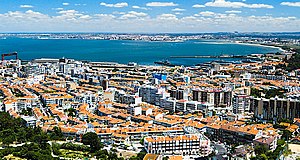Puerto del Rey
Puerto del Rey | |
|---|---|
City and Municipality | |
| Gran Ciudad de Puerto del Rey Great City of Puerto del Rey | |
Following down left to right: Obrador Square, Puerto Train Station, the Cradle of the Cross, The Fallen of the War Monument, Cityscape of Puerto del Rey, National Auratian Museum, St. Stephen's Cathedral, Tilto Market, New Puerto del Rey | |
| Motto(s): "Pro Deo crucem meum fero" (Solarian: For God I do bear my cross ) | |
| Founding as Mursa | 83 B.C. |
| City Status | 23 A.D. |
| Made capital | 8 August 1573 |
| Disinvested | 12 June 1965 |
| Government | |
| • Type | Council-manager |
| • Mayor | Oriol Jiménez (L) |
| • Chairman of the Government Board | Dario Vaquero Cedillo (L) |
| Area | |
| • City and Municipality | 433.1 km2 (167.2 sq mi) |
| • Land | 400.2 km2 (154.5 sq mi) |
| • Water | 32.9 km2 (12.7 sq mi) |
| Population (2018) | |
| • City and Municipality | 961,494 |
| • Density | 2,200/km2 (5,700/sq mi) |
| • Urban | 470,942 |
| • Metro | 1,436,935 |
| Demonym | Reians |
| Postal Code | 1000-100 |
| Area code | +1 |
Puerto del Rey (English: Port of the King), formally the Gran Ciudad de Puerto del Rey (English: Great City of Puerto del Rey), known historical as Mursa, Corona d'Este, or Puerto del Príncipe is the second-most populous city in Auratia and the most populous city in the state of Saba. The city is home to a population of roughly 961 thousand inhabitants with a metropolitan area population of roughly 1.4 million. The municipality covers roughly 433.1 km2 (167.2 sq mi). Puerto del Rey is the former capital city of Auratia, but lost that distinction to Cienflores in 1965.
Puerto del Rey lies on the Doro River, which empties out into the Auratian Bay and further into the Sea of Assonaire. A coastal city, Puerto del Rey sits on mostly flat terrain at the mouth of the aformentioned Auratian Bay.
The site of the present city of Puerto del Rey was settled as early as 1,000 BC, though evidence suggests sparse human habitation as early as 3,500 BC. Puerto del Rey covers what was an advanced and thriving trading community of Tenics who interacted regularly with the Solarian Empire. The Tenics who lived in or around modern-day Puerto del Rey are thought to be among the most prosperous, regularly trading gold, silver, iron, and their fine weaving. Recognizing the strategic importance of the area, Solarian forces landed near the present-day city and set up military camps around 100 BC. As settlers from the empire began to pour into the Auratian Peninsula, some settlers founded a small hamlet called Mursa, which may come from the previous Tenic-language word for the area.
On account of its prized location, Mursa quickly grew and expanded. It was recognized as a formal city and incorporated into the Solarian Empire's trade routes by 23 AD. Mursa became the capital of the Solarian Empire's administration of the Auratian Peninsula. Around beginning of the third century, the dogma of the Solarian Catholic Church began to spread in Mursa's walls. Though it was heavily oppressed across the peninsula, the Sotirian religion gained ground. Maximus Faber, the Sotirian governor of Mursa, ordered the construction of the Cradle of the Cross, one of Euclea's oldest churches, in 390 AD. After the fall of the Solarian Empire, Mursa became the administrative capital of the Verliquoian Empire, where it would be the subject of attack and destruction by Tagamic hordes in the 9th century.
After Verliquoian Rule was shaken off, the city became part of the Mursa Principality, and acquired the name Puerto del Príncipe. Corona d'Este would become the peninsula's most prosperous city, and its leaders were the most powerful rulers of Auratia. The city would be conquered and subjugated by Christian of Efrasia. Christian of Efrasia would be declared the King of Auratia, taking Puerto del Príncipe, now named Puerto del Rey, as his capital. The monarchy would fall, however, when the Alzamiento, a republican revolution, cultimated in a coup d’état in Puerto del Rey and the establishment of a republic on 13 January 1820.










